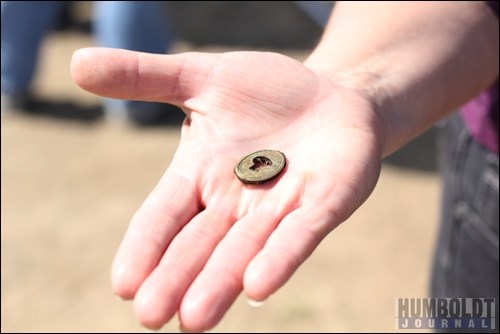Just a few kilometres southwest of Humboldt, almost lost among bright yellow fields of canola, there is a small clearing. At first glance it's notable only for its drabness amidst the surrounding explosion of colour. Yet look closer and there's more than meets the eye. Here, volunteers and archaeologists pick away at dry, sandy soil, a tedious and unforgiving task. There are deep trenches that expose the earth and offer tantalizing glimpses of what once was. These people are looking for something, anything - an old can, a spent cartridge, the bones of a horse. Here, on an idyllic summer day, these people are looking for pieces of Canadian history.
Now little more than a dry and empty field, the area was once the temporary home of nearly 500 soldiers during the Northwest Resistance of 1885. Just beyond a copse of trees at the edge of the field is where the Humboldt telegraph station, the last reliable line of communication for Prime Minister John A. MacDonald and his forces in the West, once stood. In those days, news from the front often reached the rest of the country via the Humboldt telegraph station.
"Without this site, getting the message out would have been impossible," said Jennifer Hoesgen, curator of the Humboldt & District Museum & Gallery. "This was a major communications and supply hub."
Government troops were stationed at the site between May and July 1885, beginning with Colonel George Taylor Denison and 80 of his cavalry, who were followed by troops from the Queen's York Rangers in Ontario. The soldiers erected no permanent structures, living instead in tents. This makes determining the scale of the former camp very difficult. There are no walls or ruins to mark the boundaries, though markings on the ground may indicate the presence of latrine or garbage trenches - even fortification trenches.
Using a magnetometer, archaeologists from Western Heritage located an anomaly north of the flagpole (where the group believes the fort was located) last summer. It's their hope that this is the location of the shallow trench the troops dug during their stationing. Krista Gilliland, a geo-archaeologist for Western Heritage, and Liz Robertson, an archaeologist from the University of Saskatchewan, were immersed in a large trench dug out by their backhoe, hoping to find irregularities in the soil that would indicate a man-made trench once lay there.
In layman's terms, Gilliland explained they were mapping soil changes, pointing out the natural, parallel soil layers from the ground up and then its sudden change into layers crisscrossing into others and clay deposits where they simply shouldn't be.
"It's my feeling that the soldiers dug the trench and because the ground was loose dirt, they used clay to stabilize it," Robertson said.
Gilliland said that the irregularities in the soil led her to believe it's very possible the team had finally discovered the trench.
Whether they did or not, it's certainly there - August Faul's brother, the son of Josef Faul who homesteaded the land in the early 1900s, remembered playing in the trenches as a young boy.
"The site is a great archaeological puzzle," said Jim Finnigan of Western Heritage, gesturing to the land around him that offers few clues. "Military sites aren't great for archaeologists because they're so clean," Finnigan continues. "They're the kind of places where if you throw a chicken bone on the ground, someone tells you to pick it up." He pauses and chuckles. "From an archaeological point of view, we love garbage."
Finnigan has been visiting the site since the mid-1990s. Back then the land was privately owned and there was little opportunity for a serious dig. In 2009, the Humboldt & District Museum & Gallery purchased the land and entrusted it to the city, paving the way for the full-scale operation that's been going on over the past few weeks.
A lot of the artifacts that have been found seem pedestrian, but offer valuable insights into life at a 19th century military camp. There have been several cans of corned beef and canned headcheese found, proving military rations have always left something to be desired.
Peggy McKeand has been an archaeologist for 30 years and uses ground-penetrating radar (GPR) to find anomalies in the soil. She wheels the device along the surface she wants to explore, then downloads the data into a program called Echo Mapper, which will highlight irregularities the GPR discovered in the ground.
"The GPR found an anomaly over at the ridge," McKeand said, adding they're hoping to explore that area next summer.
There have been some more unique finds among the mundane. Hoesgen gently slides what seems to be a keyhole out of a plastic bag. Finnigan thinks it probably secured a soldier's kit bag at one time, but as with any piece from the site, the truth is uncertain at best. Even the dimensions of the famous telegraph station were hard to determine.
"There were some pictures, but in every one there was a horse in the way or we didn't know how tall the soldier was standing next to the station, so there was no sense of scale," Finnigan said. "Then someone noticed a bottle in the window in one of the pictures and said 'I know that bottle!' He found the exact dimensions of the bottle and from there we figured out how big the station was."
If there are any more mysteries locked in the soil, they'll probably be uncovered the same way; by chance, a lucky stab in the dirt or a glimpse of some long-forgotten piece of rusted metal. It almost happens on this day. There are cries of excitement from the museum volunteers; they think they've found something. Just as soon as the cries go up, though, they fade away. It's a false alarm. They turn back to the dry, sandy soil, all looking for a little piece of Canadian history.




